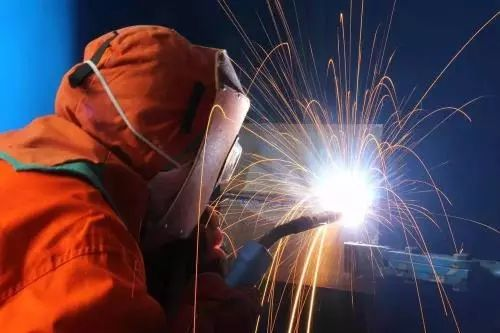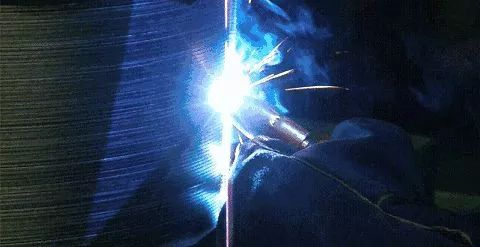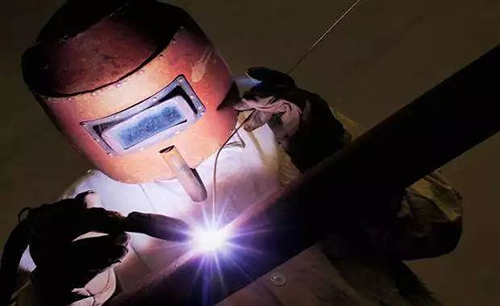There are many things that need to be paid attention to during the welding process. If ignored, it may lead to big mistakes.
Details determine success or failure, please read it patiently!
1 Don’t pay attention to choosing the best voltage during welding construction
[Phenomena] During welding, regardless of the size of the groove, whether it is base, filling or covering, the same arc voltage is selected. In this way, the required penetration depth and width may not be achieved, and defects such as undercuts, pores, and spatter may occur.
[Measures] Generally, the corresponding long arc or short arc should be selected for different situations to obtain better welding quality and work efficiency.
For example, short arc operation should be used in order to obtain better penetration during bottom welding, and the arc voltage can be appropriately increased in order to obtain higher efficiency and melting width during fill welding or cover welding.
2 Welding does not control the welding current
[Phenomena] During welding, in order to gain progress, the butt welds of medium and thick plates are not grooved. The strength index drops, or even fails to meet the standard requirements, and cracks appear during the bending test. This will make the performance of the weld joint unable to be guaranteed and pose a potential hazard to the structural safety.
[Measures] When welding, the welding current should be controlled according to the process evaluation, and a 10 to 15% fluctuation is allowed. The blunt edge size of the groove should not exceed 6mm. When docking, when the plate thickness exceeds 6mm, bevels must be made for welding.
3 Not paying attention to the coordinated use of welding speed, welding current, and electrode diameter
[Phenomena] When welding, do not pay attention to controlling the welding speed and welding current, and coordinate the use of electrode diameter and welding position.
For example, when performing primer welding on a fully penetrated corner seam, due to the narrow root size, if the welding speed is too fast, the root gas and slag inclusions do not have enough time to be discharged, which may easily cause defects such as incomplete penetration, slag inclusions, and pores in the root. ; When welding the cover, if the welding speed is too fast, it is easy to produce pores; if the welding speed is too slow, the weld reinforcement will be too high and the shape will be irregular; when welding thin plates or welds with small blunt edges, the welding speed will be too high. Slow and prone to burnout and other situations.
[Measures] Welding speed has a significant impact on welding quality and welding production efficiency. When selecting, select the appropriate welding speed according to the welding current, welding seam position (bottom welding, filling welding, cover welding), welding seam thickness, and groove size. Speed, on the premise of ensuring penetration, easy discharge of gas and welding slag, no burn-through, and good formation, a higher welding speed is selected to improve productivity and efficiency.
4 Failure to pay attention to arc length control during welding
[Phenomena] During welding, the arc length is not properly adjusted according to the groove form, number of welding layers, welding form, electrode model, etc. Due to improper use of welding arc length, it is difficult to obtain high-quality welds.
[Measures] In order to ensure the quality of the weld, short arc operations are generally used during welding, but the appropriate arc length can be selected according to different situations to obtain the optimal welding quality, such as the first step of V-shaped groove butt joints and corner joints. The first layer should use a shorter arc to ensure penetration without undercutting, and the second layer can be slightly longer to fill the weld. When the weld gap is small, a short arc should be used. When the gap is large, the arc can be slightly longer and the welding speed will be accelerated. The arc for overhead welding should be the shortest to prevent molten iron from flowing downwards; in order to control the temperature of the molten pool during vertical and horizontal welding, small current and short arc welding should also be used.
In addition, no matter what kind of welding is used, attention should be paid to keeping the arc length basically unchanged during the movement to ensure that the penetration width and penetration depth of the entire weld are consistent.
5 Welding without paying attention to controlling welding deformation
[Phenomena] When welding, you do not pay attention to controlling deformation from the aspects of welding sequence, personnel arrangement, groove form, welding specification selection and operation methods, etc., which leads to large deformation after welding, difficulty in correction, and increased cost, especially for thick plates and large workpieces. Correction is difficult, and mechanical correction can easily cause cracks or lamellar tears. The cost of flame correction is high and poor operation can easily cause overheating of the workpiece.
For workpieces with high precision requirements, if effective deformation control measures are not taken, the installation dimensions of the workpiece will not meet the usage requirements, and may even result in rework or scrapping.
[Measures] Adopt a reasonable welding sequence and select appropriate welding specifications and operating methods, as well as anti-deformation and rigid fixing measures.
6 Multi-layer welding is carried out discontinuously and no attention is paid to controlling the temperature between layers
[Phenomena] When welding multi-layer thick plates, do not pay attention to the temperature control between layers. If the interval between layers is too long, welding without reheating will easily cause cold cracks between layers; if the interval is too short, the temperature between layers will If the temperature is too high (exceeding 900°C), it will also affect the performance of the weld and the heat-affected zone, causing coarse grains, resulting in a decrease in toughness and plasticity, and leaving potential hazards in the joints.
[Measures] When welding multi-layer thick plates, the control of the inter-layer temperature should be strengthened. During the continuous welding process, the temperature of the welding base material should be checked to ensure that the inter-layer temperature is as consistent as possible with the preheating temperature. The maximum temperature must also be controlled.
The welding time should not be too long. In case of welding interruption, appropriate post-heating and heat preservation measures should be taken. When welding again, the re-preheating temperature should be appropriately higher than the initial preheating temperature.
7 Multi-layer welds are welded on the lower layer without removing welding slag and defects on the weld surface.
[Phenomena] When multi-layer welding of thick plates, welding of the lower layer is carried out directly without removing the welding slag and defects after each layer of welding. This can easily cause defects such as slag inclusions, pores, cracks and other defects in the weld, reducing the connection strength and causing welding of the lower layer. time splash.
[Measures] When welding thick plates in multiple layers, each layer should be welded continuously. After each layer of welding seam is welded, welding slag, welding seam surface defects and spatter should be removed in time. If any defects such as slag inclusions, pores, cracks and other defects that affect the welding quality are found, they should be completely removed before welding.
Xinfa welding equipment has the characteristics of high quality and low price. For details, please visit: Welding & Cutting Manufacturers – China Welding & Cutting Factory & Suppliers (xinfatools.com)
8 Insufficient fillet size for joint butt or corner butt combination welds requiring penetration
[Phenomena] Butt or corner butt combination welds that require penetration such as T-shaped joints, cross joints, corner joints, etc. have insufficient weld leg size, or the web and upper wing of a crane beam or similar component that requires fatigue calculation are designed. If the size of the weld leg of the plate edge connection weld is insufficient, the strength and stiffness of the weld will not meet the design requirements.
[Measures] T-shaped joints, cross joints, corner joints and other butt combination welds that require penetration should be in accordance with the design requirements and must have sufficient welding legs. Generally, the welding leg size should not be less than 0.25t (t is the connection point thinner plate thickness). The leg size of the weld connecting the web and upper flange of a crane beam or similar web plate that is designed to require fatigue verification is 0.5t and should not be larger than 10mm. The allowable deviation of welding dimensions is 0~4 mm.
9 Welding plugs the welding rod tip or iron block into the joint gap
[Phenomena] Since it is difficult to fuse the electrode tip or iron block with the welded piece during welding, welding defects such as lack of fusion and lack of penetration will result, and the connection strength will be reduced. If the welding rod head or iron block is filled with rust, it is difficult to ensure that the material is consistent with the base material; if the welding rod head or iron block is filled with oil stains, impurities, etc., it will cause defects such as pores, slag inclusions, and cracks in the weld. These conditions will greatly reduce the quality of the welds of the joints and fail to meet the quality requirements of the design and specifications for the welds.
【measure】
(1) When the assembly gap of the workpiece is large, but does not exceed the allowable use range, and the assembly gap exceeds 2 times the thickness of the sheet or is greater than 20mm, the surfacing method should be used to fill the recessed parts or reduce the assembly gap. It is strictly prohibited to use the method of filling the welding rod head or iron block repair welding in the joint gap.
(2) When processing and marking parts, attention should be paid to leaving sufficient cutting allowance and welding shrinkage allowance after cutting, and controlling the size of the parts. Do not increase the gap to ensure the appearance size.
10 Not paying attention to the welding sequence of components with cross welds
[Phenomena] For components with cross welds, we do not pay attention to the reasonable arrangement of the welding sequence by analyzing the welding stress release and the impact of welding stress on component deformation, but weld randomly vertically and horizontally. As a result, the vertical and horizontal seams will be constrained with each other, resulting in larger The temperature shrinkage stress will cause the plate to deform, make the plate surface uneven, and may cause cracks in the welds.
[Measures] For components with cross welds, a reasonable welding sequence should be developed. When there are several vertical and horizontal cross welds to be welded, the transverse seams with larger shrinkage deformation should be welded first, and then the longitudinal welds. In this way, the transverse welds will not be constrained by the longitudinal welds and the shrinkage stress of the transverse seams will be reduced. Being released without restraint can reduce welding deformation and ensure weld quality, or weld butt welds first and then fillet welds.
Post time: Nov-01-2023






